 |
surfresearch.com.au
the afx, 2013
|
The Asymmetic Fin Experiment, 2013
| home | catalogue | history | references | appendix |
 |
surfresearch.com.au
the afx, 2013
|
|
In the early 1963, Australian and
Makaha champion, Midget Farrelly designed the Off-set
Square "with one side longer than the other ...
designed to eliminate one of the surfboard rider's major
problems - perfecting the backhand turn."
- Kevin Platt in Pollard: Australian Surfrider (1963) page 24. Around the same time, Scott Dillon Surfboards, Brookvale, produced the Hook-tail, possibly derived from a California, where one rail had extended curvature. Left:
Scott Dillon Surfboards: Hook-tail, 1963. Photograph: Unaccredited - Pollard: Australian Surfrider (1963) page 26. |
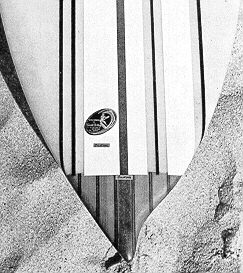 |
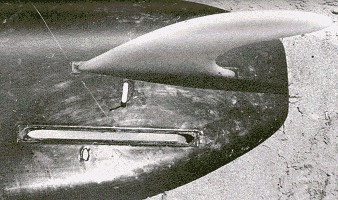 |
Left:
additional control skegs [Offset Fin Boxes], 1965. Photograph: Unaccredited. Bill Cleary: Nose Riding - A sport within a sport. Surfer,Volume 6 Number 5, November 1965, page 33. An experiment demonstrated at Tom Morey's Noseriding Contest, 1965. |
| The following year, Bob
Cooper's Blue Machine for Morey-Pope Surfboards,
featured an offset fin box. Left: a. Bob Cooper: Off-set Fin box, Blue Machine, Morey-Pope Surfboards, 1966. b. Removable fin with Wonder Bolt, Morey-Pope Surfboards, 1966. - Surfboards Shaped by Davenport, viewed 3 November 2013. http://adamdavenport.blogspot.com.au/2011/07/blue-machine.html With far less extreme positioning than the Noseriding Contest model, above, the finbox is only marginally off-set from the centre line. |
 |
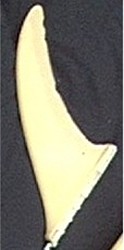 |
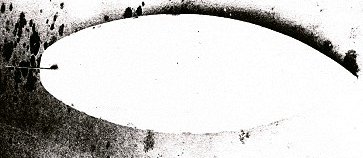 |
This
is a picture of my board for going left or backhand. It's five to seven years old and is in fact the same one I was riding on those lefts at the beginning of "Morning of the Earth". Nat Young: Nat's Backhand Board Tracks, January 1976 Number 64 Page 33. Photograph (rotated) by Frank Pithers. |
|
During the late 1970s,
Bob McTavish designed a series of asymmetical templates,
particularly for his favoured powerful North Coast
righthand point breaks.
McTavish noted the asymmetry of the rider's stance: "Forehand you apply pressure through knees, ankles and toes ... backhand the pressure goes much more directly ... pushing into heels." Left: Bob McTavish, daughter, and asymmetric surfboard, 1976. Photograph: Bob McTavish Collection. - Bob McTavish : The Asymmetric Story Seanotes, August/September 1978, pages 38-39. |
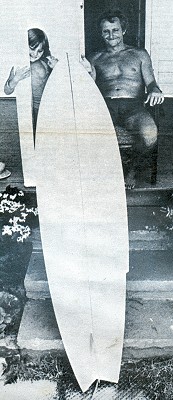 |
| At the end of the 1970s,
small wave performance surboard design was split almost
evenly between the (original, but by now highly modified)
single fin and Twin-fins, as ridden by Newcastle's
Mark Richards, one of the elite surfers of the period. In the early 1980s, Queenslanders, Peter Drouyn and Peter Townend introduced asymmetric twin-fin surfboards, with a small fin on (their) forehand rail and a larger fin off-set towards the backhand rail. Right: Peter Drouyn: Asymmetic Twin Fins, 1980. Photograph : Jeff Hornbaker. Surfing, Volume 19 Number 9, September 1980, page 87. |
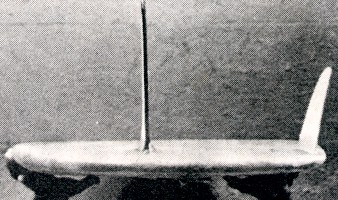 |
| Right: Peter Townend: Bi - Fin , Bronzed Aussie Surfboards/ G & Surfboards, 1981. Photograph : Guy Motil Surfer, Volume 22 Number 10, October 1981, page 42. Asymmetrical board template and corresponding asymmetric fin placement. Also see Peter Townend: Two, Two, Two Boards in One Surfing, Volume 17 Number 6, June 1981, page 27. |
| In May 2013, Ken Grieves
donated a Bombora sailboard shaped by Mark Paul circa
1995, retrieved from a northern Sydney suburb kerbside, to
my collection. Unusually, it was fitted with four fin boxes and three fins. The foot straps were removed, the fins replaced (photograph right), and a legrope attached before the board was ridden on four waves for a reasonable distance. These were five foot (that is, the wave face, after Bascom, 1964) right handers, my forehand, and in a stron off-shore wind. Despite the clear difficulty in adjusting to a "new" board, it felt "more precise" on my forehand and "losser" my backhand. |
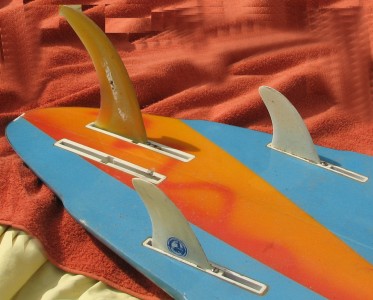 |
| Unfortunately, such a
program is beyond both my current resources, and my
ability. However, to demonstrate comittment to the concept, in November 2013, a second finbox was fitted to my current Malibu board, #214, by DSN Surfboards, Gerringong. The new box was set 1 1/2 in. from the centre line, and re-set with the previous fin combination, which is in itself, mariginally, asymmetric. Centre fin: (Unknown) sailboard fin, 10 1/2 in. x 4 in. b @ 8 in., with Canard fin, 2 in. x 1 1/2 in. b. Left Fin: FCS TC Red Line, 4 1/2 in. x 4 1/2 in. b @ 16 in. Right Fin: FCS Drive, 4 1/2 in. x 5 in. b @ 16 in. Photograph, right. ( Yes, the FCS Drive fin is designed for the left hand rail) |
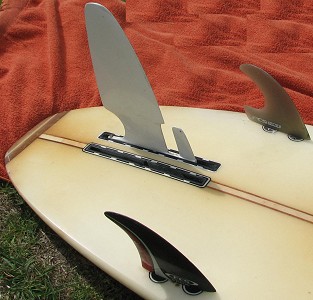 |